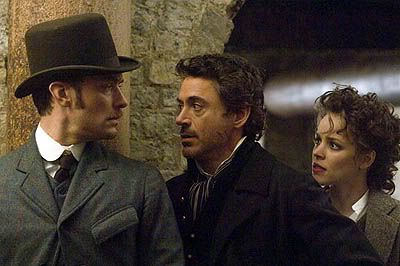
Purists beware: Sherlock Holmes bears the stamp of its director, Guy Ritchie, much more so than that of Sir Arthur Conan Doyle, the author who created the famed British sleuth and his trusty sidekick, Dr. Watson.
That’s not necessarily a bad thing—Ritchie’s film is an entertaining romp through 1880s London with just enough of the grit and grime he typically brings to his modern British gangster movies (which include Lock, Stock and Two Smoking Barrels and Snatch) to counteract the largely computer-generated cityscape.
As the title character, Robert Downey Jr. doesn’t look the part and, in fact, he doesn’t even play the part as written by Conan Doyle. Important characteristics are there—Holmes’s deductive reasoning, his focus on seemingly insignificant details, his ability to form a short biography after briefly observing an individual, his need for constant brain activity (he fills the void between cases with drink, as opposed to morphine and cocaine as in Conan Doyle’s stories), his ongoing game of one-upmanship with Scotland Yard.
But whereas Conan Doyle’s Holmes is mostly reserved and businesslike, Downey plays him as a bit of a rogue, with hints of his own Tony Stark from Iron Man and Jack Sparrow-like quirkiness. He’s even one to swoon for a lady, in this case Irene Adler (Rachel McAdams), a woman from his past and the only person to ever outsmart him.
Holmes is a buddy movie more than anything else, with Jude Law as Watson, Holmes’s friend, flatmate and biographer (Watson narrates all but four of Conan Doyle’s stories). As the film begins, Watson is planning a move from 221B Baker Street to live with Mary Morstan (Kelly Reilly), who he intends to marry.
The case involves Lord Blackwood (Mark Strong), who is hanged after committing a series of ritual murders, then seemingly rises from the grave. There is a mystery to unravel, but Ritchie focuses more on action and adventure—not as big a stretch as you might think, as Watson makes references early in the first Holmes story, “A Study in Scarlet,” to Holmes being a boxer and expert swordsman.
Ritchie’s approach to shooting and editing the action—using fast and slow motion—doesn’t quite fit, though the modern aesthetics further separate this Holmes from what has come before.
Because the plot is uninvolving and the sequel setup is as heavy-handed as it gets, it’s the actors who carry the day, particularly Downey and Law. Their interplay is the movie’s greatest strength. We could do much worse than following them on another case.
Grade: B
(Rated PG-13 for intense sequences of violence and action, some startling images and a scene of suggestive material. 128 minutes.)
No comments:
Post a Comment